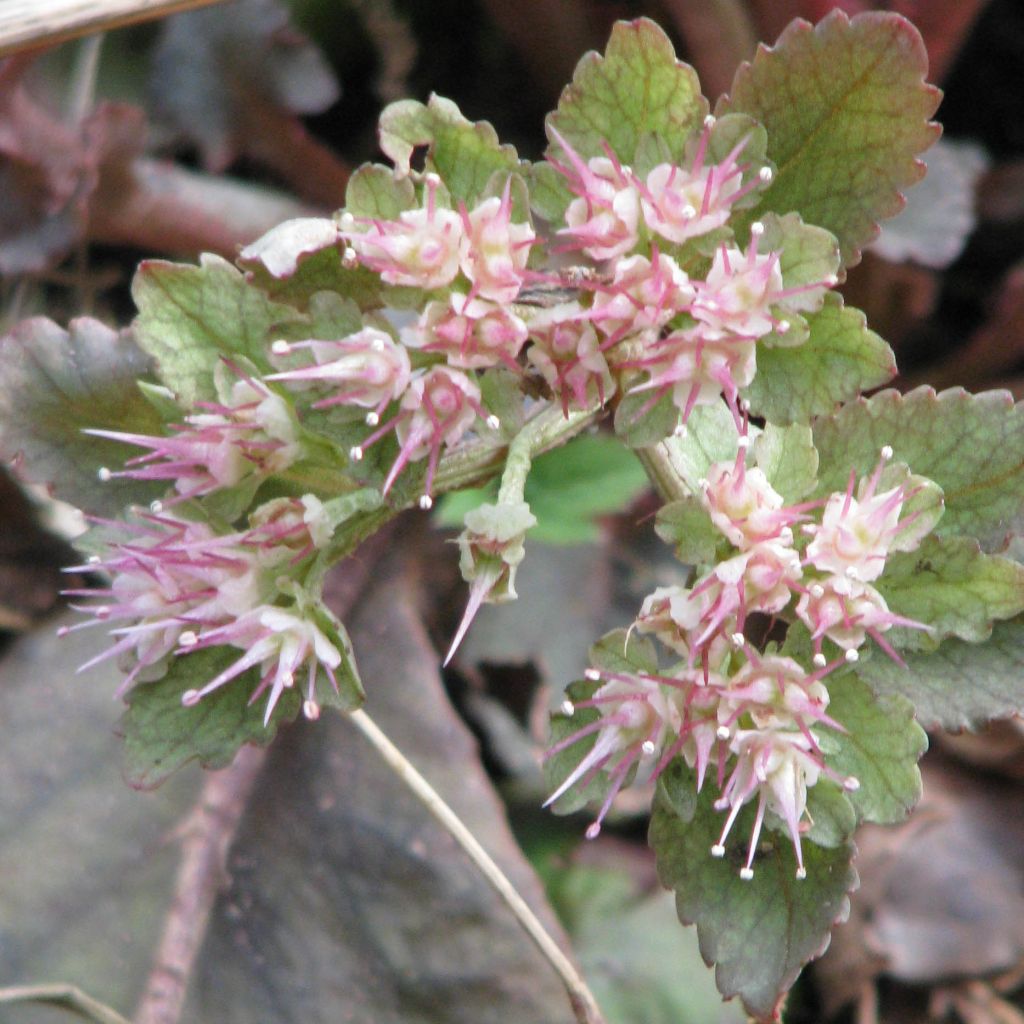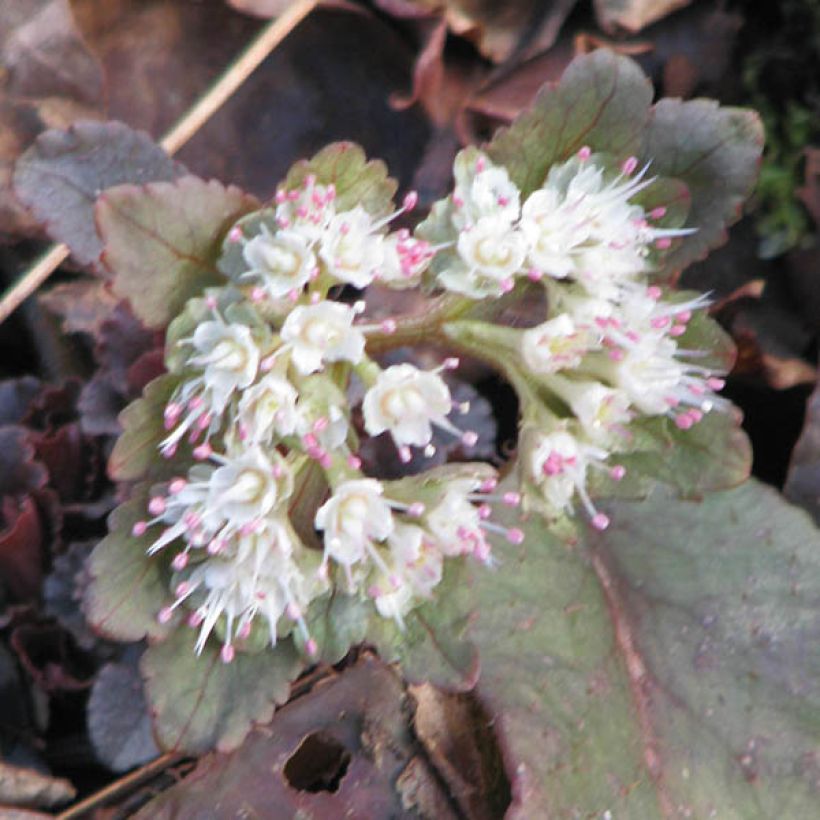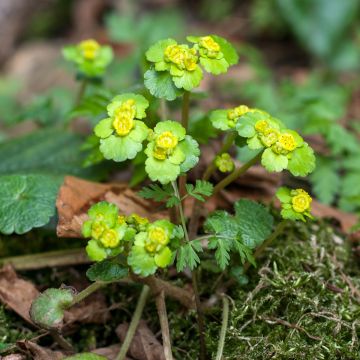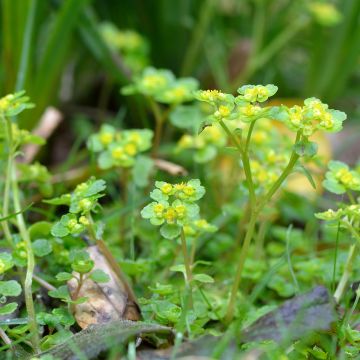

Chrysosplenium macrophyllum, Dorine
Chrysosplenium macrophyllum
Chrysosplenium macrophyllum
Giant Golden Saxifrage
This plant carries a 12 months recovery warranty
More information
We guarantee the quality of our plants for a full growing cycle, and will replace at our expense any plant that fails to recover under normal climatic and planting conditions.
From €5.90 for pickup delivery and €6.90 for home delivery
Express home delivery from €8.90.
Does this plant fit my garden?
Set up your Plantfit profile →
Description
Chrysosplenium macrophyllum, also known as the Large-leaved Golden Saxifrage, is a perennial plant that makes an excellent shade ground cover in moist and clayey soils. This evergreen Chinese species is reminiscent of a Bergenia with its large fleshy leaves and clusters of white-pink flowers from late winter. Very hardy and decorative, it spreads rapidly through its stolons, eventually forming an original, dense carpet. Worth discovering!
Chrysosplenium macrophyllum belongs to the saxifrage family. It is native to China, specifically the eastern Yunnan, where it grows at an altitude of 1200 m. Its natural habitat consists of humid forest undergrowth. It is a very hardy, vigorous perennial plant that spreads fairly quickly through stolons, similar to strawberries. At their tips, a small rosette emerges which will take root upon contact with the soil. Its vegetation is evergreen and exceeds 15 cm (6in) in height, quickly covering an area of 1 m² or more, spreading without theoretical limits. This species forms rosettes of tough, ovate leaves up to 20 cm (8in) long with wavy edges, and hairy on both sides. The glaucous green leaves take on beautiful reddish tones in the cold. Slightly fragrant flowering occurs between January and March-April depending on the climate. In late winter, a thick reddish stem covered with fine white scales emerges from the foliage bearing clusters of small flowers with toothed petals at its tip from which fine stamens escape, surrounded by green or pinkish, toothed, bracts.
Golden saxifrages are plants for damp shade which are low-maintenance once they are well established. The Large-leaved Golden Saxifrage is one of the prettiest and slightly less demanding in terms of water, being satisfied with not-too-dry garden soil in summer, rich in humus and clay. It can be used as a ground cover as well as for greening damp and shaded rockeries. A lovely scene can be created by planting it with other cool shade perennials, such as lungworts, pink astilbes, Virginia bluebells, Virginia spiderworts, and even hellebores that bloom at the same time.
Report an error about the product description
Chrysosplenium macrophyllum in pictures


Flowering
Foliage
Plant habit
Botanical data
Chrysosplenium
macrophyllum
Saxifragaceae
Giant Golden Saxifrage
China
Other Chrysosplenium
Planting and care
Chrysosplenium macrophyllum should be planted in shade or partial shade, in soil rich in humus and clay, moist to damp, and not completely drying out in summer. Avoid waterlogged soils. If the conditions are met, this plant is easy to grow once it is well established. It is hardy but it may be useful to mulch it in winter to protect the foliage in particularly cold winter regions (below -15 °C). This perennial is sensitive to sunlight and limestone.
Planting period
Intended location
Care
This item has not been reviewed yet - be the first to leave a review about it.
Haven't found what you were looking for?
Hardiness is the lowest winter temperature a plant can endure without suffering serious damage or even dying. However, hardiness is affected by location (a sheltered area, such as a patio), protection (winter cover) and soil type (hardiness is improved by well-drained soil).

Photo Sharing Terms & Conditions
In order to encourage gardeners to interact and share their experiences, Promesse de fleurs offers various media enabling content to be uploaded onto its Site - in particular via the ‘Photo sharing’ module.
The User agrees to refrain from:
- Posting any content that is illegal, prejudicial, insulting, racist, inciteful to hatred, revisionist, contrary to public decency, that infringes on privacy or on the privacy rights of third parties, in particular the publicity rights of persons and goods, intellectual property rights, or the right to privacy.
- Submitting content on behalf of a third party;
- Impersonate the identity of a third party and/or publish any personal information about a third party;
In general, the User undertakes to refrain from any unethical behaviour.
All Content (in particular text, comments, files, images, photos, videos, creative works, etc.), which may be subject to property or intellectual property rights, image or other private rights, shall remain the property of the User, subject to the limited rights granted by the terms of the licence granted by Promesse de fleurs as stated below. Users are at liberty to publish or not to publish such Content on the Site, notably via the ‘Photo Sharing’ facility, and accept that this Content shall be made public and freely accessible, notably on the Internet.
Users further acknowledge, undertake to have ,and guarantee that they hold all necessary rights and permissions to publish such material on the Site, in particular with regard to the legislation in force pertaining to any privacy, property, intellectual property, image, or contractual rights, or rights of any other nature. By publishing such Content on the Site, Users acknowledge accepting full liability as publishers of the Content within the meaning of the law, and grant Promesse de fleurs, free of charge, an inclusive, worldwide licence for the said Content for the entire duration of its publication, including all reproduction, representation, up/downloading, displaying, performing, transmission, and storage rights.
Users also grant permission for their name to be linked to the Content and accept that this link may not always be made available.
By engaging in posting material, Users consent to their Content becoming automatically accessible on the Internet, in particular on other sites and/or blogs and/or web pages of the Promesse de fleurs site, including in particular social pages and the Promesse de fleurs catalogue.
Users may secure the removal of entrusted content free of charge by issuing a simple request via our contact form.
The flowering period indicated on our website applies to countries and regions located in USDA zone 8 (France, the United Kingdom, Ireland, the Netherlands, etc.)
It will vary according to where you live:
- In zones 9 to 10 (Italy, Spain, Greece, etc.), flowering will occur about 2 to 4 weeks earlier.
- In zones 6 to 7 (Germany, Poland, Slovenia, and lower mountainous regions), flowering will be delayed by 2 to 3 weeks.
- In zone 5 (Central Europe, Scandinavia), blooming will be delayed by 3 to 5 weeks.
In temperate climates, pruning of spring-flowering shrubs (forsythia, spireas, etc.) should be done just after flowering.
Pruning of summer-flowering shrubs (Indian Lilac, Perovskia, etc.) can be done in winter or spring.
In cold regions as well as with frost-sensitive plants, avoid pruning too early when severe frosts may still occur.
The planting period indicated on our website applies to countries and regions located in USDA zone 8 (France, United Kingdom, Ireland, Netherlands).
It will vary according to where you live:
- In Mediterranean zones (Marseille, Madrid, Milan, etc.), autumn and winter are the best planting periods.
- In continental zones (Strasbourg, Munich, Vienna, etc.), delay planting by 2 to 3 weeks in spring and bring it forward by 2 to 4 weeks in autumn.
- In mountainous regions (the Alps, Pyrenees, Carpathians, etc.), it is best to plant in late spring (May-June) or late summer (August-September).
The harvesting period indicated on our website applies to countries and regions in USDA zone 8 (France, England, Ireland, the Netherlands).
In colder areas (Scandinavia, Poland, Austria...) fruit and vegetable harvests are likely to be delayed by 3-4 weeks.
In warmer areas (Italy, Spain, Greece, etc.), harvesting will probably take place earlier, depending on weather conditions.
The sowing periods indicated on our website apply to countries and regions within USDA Zone 8 (France, UK, Ireland, Netherlands).
In colder areas (Scandinavia, Poland, Austria...), delay any outdoor sowing by 3-4 weeks, or sow under glass.
In warmer climes (Italy, Spain, Greece, etc.), bring outdoor sowing forward by a few weeks.





































